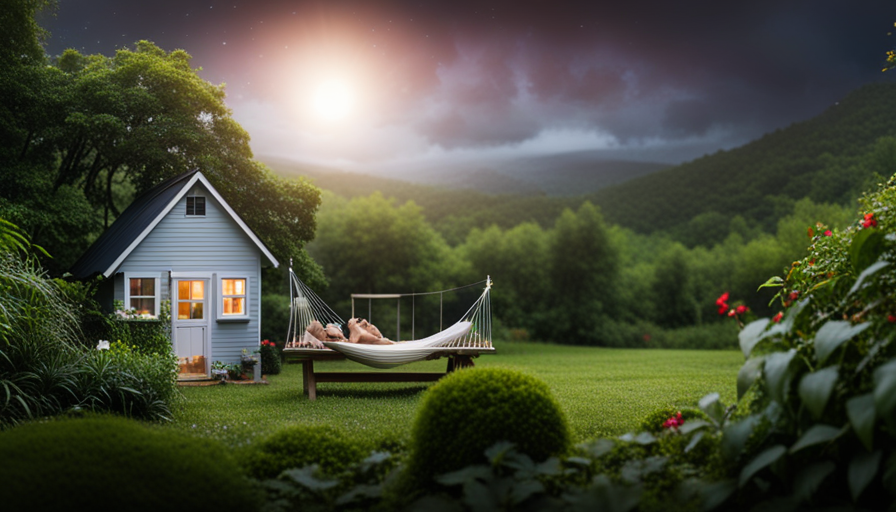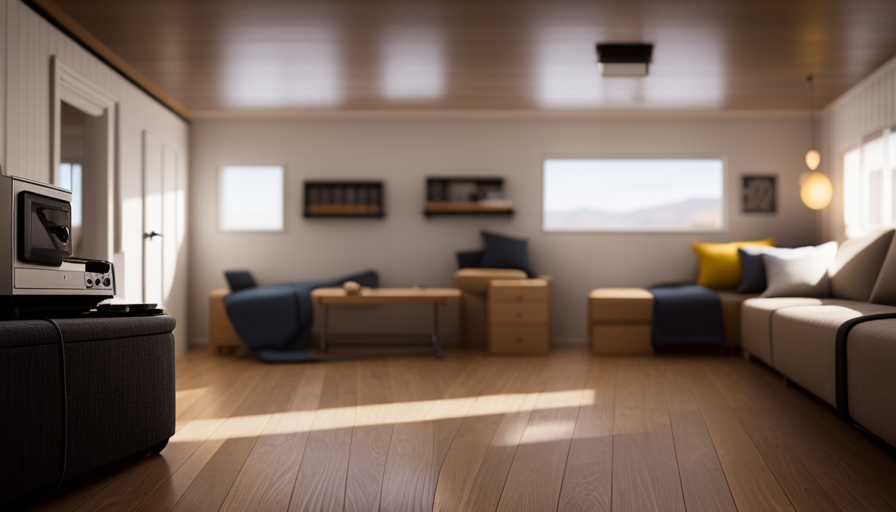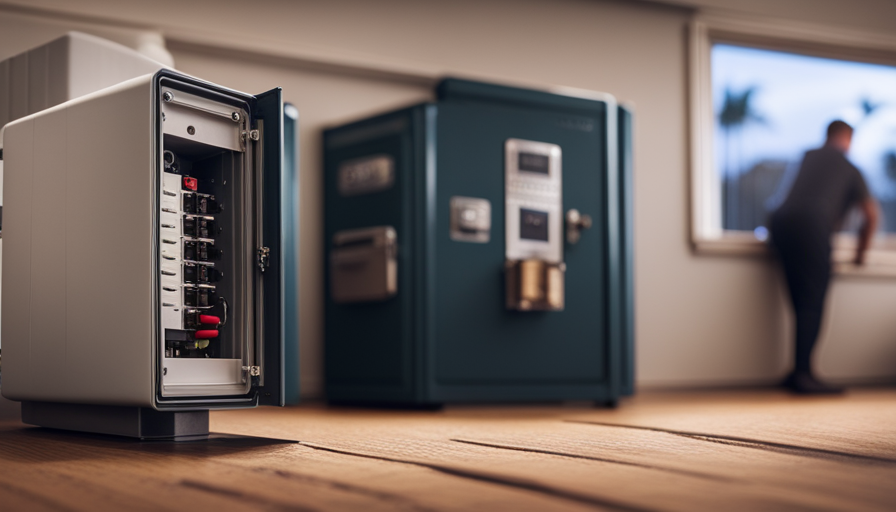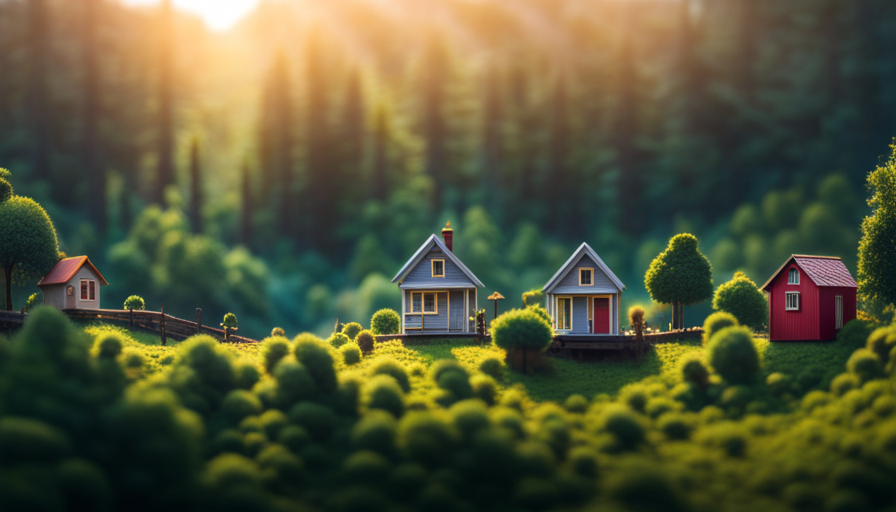Do you ever feel like the excess of modern life is overwhelming you? I certainly do. The constant accumulation of belongings, the never-ending need for more space, and the relentless quest for more can leave us feeling overwhelmed and disconnected from what truly matters.
That’s why I decided to take a leap of faith and build my own tiny house. A tiny house is not just a physical structure; it’s a metaphor for simplifying our lives and prioritizing the things that truly bring us joy. It’s about embracing minimalism and living with intention. But building a tiny house is no small feat. It requires careful planning, attention to detail, and a whole lot of patience.
In this article, I will share with you the step-by-step process of building a tiny house, from determining your needs and goals to enjoying the final product. So grab your tools and join me on this journey of self-discovery and sustainable living. Let’s build our own little piece of paradise together.
Key Takeaways
- Building a tiny house requires careful planning, attention to detail, and patience.
- It is important to research and gather inspiration for design ideas and floor plans, as well as explore different styles and materials for tiny houses.
- Zoning laws, building codes, and access to utilities and amenities should be thoroughly researched and considered to avoid legal issues and ensure convenience and comfort.
- The construction process includes building the foundation and frame, installing electrical and plumbing systems, insulating the house, and completing interior and exterior finishes. Regular maintenance is also necessary for longevity and functionality.
Determine Your Needs and Goals
Figure out what you want and need in a tiny house so you can start planning your dream home. Setting priorities is crucial in this process. Think about your lifestyle and what features are important to you. Do you need a home office? Or maybe a spacious kitchen is a priority for you. By determining your needs, you can create a functional and comfortable living space.
Setting a budget is another important step. Tiny houses can be cost-effective, but it’s still essential to plan your finances wisely. Consider the cost of materials, labor, and any additional expenses that may arise during the construction process. Creating a budget will help you stay on track and avoid overspending.
In addition to setting priorities and a budget, it’s also essential to research and gather inspiration for your tiny house. Look for design ideas, layouts, and storage solutions that resonate with your vision. This will help you refine your plans and create a home that meets your needs and reflects your personal style.
Once you have determined your needs and goals, and have gathered inspiration, you can move forward with confidence to the next step of building your tiny house.
Research and Gather Inspiration
When researching and gathering inspiration for building a tiny house, it’s crucial to explore different styles to find the one that resonates with your personal taste and lifestyle. By looking into various tiny house styles, you can identify the features and design elements that appeal to you the most.
Additionally, it’s important to search for design ideas and floor plans that can serve as a blueprint for your own tiny house project. These resources can provide valuable insights into space-saving solutions and efficient layouts that maximize functionality and comfort in a small space.
Explore Different Tiny House Styles
Imagine yourself wandering through a whimsical forest of tiny house styles, each one uniquely designed to enchant and inspire.
As you explore, you’ll come across an array of different tiny house materials, each with their own pros and cons. From rustic cabins made of reclaimed wood to sleek modern designs using steel and glass, the possibilities are endless.
Tiny house living offers the advantage of reduced expenses, minimal maintenance, and a smaller carbon footprint. However, it also requires careful planning and organization to maximize the limited space.
Now that you have an idea of the various styles and materials, it’s time to look for design ideas and floor plans. This will help you envision how your own tiny house can be customized to fit your needs and preferences seamlessly.
Look for Design Ideas and Floor Plans
As you browse through an array of design ideas and floor plans, let your imagination transport you to a world of endless possibilities for creating your dream tiny home. Design inspiration can come from various sources, such as magazines, websites, and even visiting model tiny houses. Take note of the features that catch your eye and consider how they can be incorporated into your own design.
It’s important to explore different floor plan options to maximize the use of space and ensure functionality. Look for layouts that suit your lifestyle and prioritize the essential elements you want in your tiny house.
Once you have gathered enough ideas and floor plans, it’s time to create a detailed plan that will guide you through the construction process seamlessly.
Create a Detailed Plan
When creating a detailed plan for building a tiny house, it’s important to start by sketching out the layout and design. This will help visualize the overall look and functionality of the space.
Additionally, making a list of all the materials and tools needed is crucial for a smooth construction process. By being knowledgeable and detail-oriented in these aspects, I can ensure a successful and efficient building experience.
Sketch Your Layout and Design
To create a more personal touch, envision how you want your tiny house layout and design to reflect your unique lifestyle. Sketching techniques can help you visualize your ideas and make adjustments before diving into the construction process.
Consider the layout of your tiny house, including the placement of rooms, windows, and doors. Think about the flow of the space and how it will accommodate your daily activities.
Additionally, consider the design elements that will make your tiny house feel like home. Do you want a rustic cabin vibe or a modern minimalist feel? Incorporate elements like color schemes, furniture choices, and decorative accents that resonate with your personal style.
By carefully considering these layout and design elements, you can create a tiny house that is truly a reflection of you.
Now, let’s move on to the next section and make a list of materials and tools needed for the construction process.
Make a List of Materials and Tools Needed
Gather up the necessary materials and tools for your construction process and get ready to bring your vision to life.
When it comes to materials selection, it’s crucial to choose high-quality and durable options that will withstand the test of time. Consider using sustainable and eco-friendly materials to create an environmentally friendly tiny house.
Some common materials needed include lumber, insulation, roofing materials, siding, and electrical wiring.
Additionally, don’t forget about the tools needed to complete the project. Ensure you have a well-stocked toolbox with essentials such as hammers, saws, screwdrivers, drills, and measuring tools.
Tool safety is of utmost importance, so always wear protective gear and follow proper safety protocols.
Once you have gathered all the necessary materials and tools, you can move on to the next step of finding a suitable location to build your tiny house.
Find a Suitable Location
When finding a suitable location for my tiny house, I need to research zoning laws and building codes to ensure that I’m in compliance and can legally build my home.
It’s important to consider access to utilities such as water, electricity, and sewage, as well as amenities like grocery stores, schools, and healthcare facilities.
By carefully considering these factors, I can ensure that I find the perfect location for my tiny house that meets all of my needs and requirements.
Research Zoning Laws and Building Codes
Ensure that you thoroughly examine zoning laws and building codes in order to construct your tiny house in compliance with local regulations.
Exploring alternative housing options and understanding the benefits of tiny living is important, but it’s equally crucial to be well-versed in the legal requirements for building a tiny house.
Zoning laws vary from place to place, so research the specific regulations in your desired location. Some areas have zoning ordinances that prohibit tiny houses or require them to be built on specific types of properties.
Additionally, building codes dictate the minimum standards for safety and habitability, so make sure your tiny house meets these requirements. Understanding the regulations will help you avoid any legal issues and ensure a smooth construction process.
Now, let’s consider access to utilities and amenities in order to plan your tiny house effectively.
Consider Access to Utilities and Amenities
Imagine the convenience and comfort of having easy access to utilities and amenities in order to fully enjoy your tiny living experience. When considering where to build your tiny house, it’s crucial to take into account the availability of utilities such as water, electricity, and sewage. Access to these resources will ensure a smooth and functional living environment.
Additionally, nearby amenities such as grocery stores, hospitals, and recreational facilities can greatly enhance your daily life. It’s important to have easy access to basic necessities and activities that contribute to your well-being.
Once you’ve identified a location that meets these criteria, you can proceed to the next step of building the foundation and frame of your tiny house, creating a solid base for your future home.
Build the Foundation and Frame
Start by laying the foundation and framing the structure for your tiny house. When building a tiny house, it’s important to determine your budget and choose the right construction materials. This will ensure that your foundation and frame are sturdy and secure.
First, you need to prepare the site for your tiny house. Clear any vegetation or debris and level the ground. Once the site is ready, you can start constructing the foundation. You have several options to choose from, such as a concrete slab, concrete blocks, or a pier and beam foundation. Consider the local climate and soil conditions to determine the most suitable option for your specific location.
After the foundation is in place, it’s time to frame the structure. Use pressure-treated lumber for the framing, as it’s resistant to moisture and decay. Follow the design plans or blueprints to accurately frame the walls, floor, and roof. Ensure that all measurements are precise and that the frame is square and level.
Once the foundation and frame are complete, you can move on to installing electrical and plumbing systems. These vital components will provide you with the necessary utilities and amenities in your tiny house.
Install Electrical and Plumbing Systems
Now that you’ve laid a solid foundation and framed the structure, it’s time to bring life and comfort to your home by installing the essential electrical and plumbing systems.
To ensure your tiny house is equipped with the necessary utilities, follow these three steps:
-
Installing Electrical Wiring: Begin by planning the electrical layout, taking into consideration the placement of outlets, switches, and lighting fixtures. Carefully run electrical wires through the walls and ceiling, making sure to follow proper safety guidelines and codes. Connect the wires to a breaker box and install the necessary outlets and switches. Finally, test the electrical system to ensure everything is functioning correctly.
-
Plumbing Installation: Start by mapping out the plumbing layout, including the locations of sinks, toilets, and showers. Install the water supply lines, using materials that are suitable for a tiny house, such as PEX tubing. Connect the lines to fixtures and appliances, ensuring proper sealing and secure connections. Install a water heater and connect it to the plumbing system. Finally, test the plumbing system for any leaks or issues.
With the electrical and plumbing systems in place, you can now move on to insulating and sealing the house, creating a comfortable and energy-efficient living space.
Insulate and Seal the House
Once the essential electrical and plumbing systems are in place, it’s time to wrap your cozy haven in a snug layer of insulation, like a warm embrace that keeps the elements at bay.
Insulating your tiny house is crucial to maintain a comfortable living environment and ensure energy efficiency. There are various insulation techniques you can employ, depending on your budget and specific needs.
One popular method is using spray foam insulation, which provides excellent coverage and seals any gaps or cracks. This type of insulation is ideal for tiny houses as it maximizes space utilization and minimizes heat loss.
Another option is installing rigid foam insulation boards, which are lightweight and easy to work with. These boards can be affixed to the walls and roof, providing a barrier against temperature fluctuations.
To enhance energy efficiency, consider using double-pane windows and insulated doors. These features will prevent heat transfer and maintain a consistent internal temperature. Additionally, sealing any air leaks around windows, doors, and electrical outlets is crucial to prevent drafts and energy loss.
With the insulation and sealing complete, your tiny house is well on its way to becoming a cozy sanctuary. The next step involves completing the interior and exterior finishes, transforming your humble abode into a charming and functional space.
Complete Interior and Exterior Finishes
Enhance the charm and functionality of your cozy haven by completing the interior and exterior finishes. As you put the final touches on your tiny house, it’s important to stay up to date with the latest tiny house decorating trends. Incorporating these trends will not only make your space feel more modern and stylish, but it will also maximize the functionality of your limited square footage.
In the interior, consider using light colors on the walls and choosing furniture that serves multiple purposes, such as a sofa that can convert into a bed or a dining table that can fold down when not in use. Additionally, adding storage solutions like built-in shelves or hidden cabinets will help keep your space organized and clutter-free.
When it comes to the exterior, landscaping can play a big role in making your tiny house feel like a home. Keep in mind that you have limited space, so choose plants that are low maintenance and won’t overtake your yard. Utilize vertical space by hanging plants or installing a vertical garden. Adding a small patio or deck can also create an inviting outdoor space to relax and entertain.
Transitioning into the next section about ‘furnish and decorate your tiny house’, it’s important to consider your personal style and make choices that reflect your taste and lifestyle.
Furnish and Decorate Your Tiny House
To truly transform your compact sanctuary into a personalized oasis, let your creativity bloom as you carefully select furnishings and decorations that effortlessly blend comfort and style. The right furniture arrangement is crucial in maximizing the limited space in your tiny house. Opt for multifunctional pieces, such as a sofa that can convert into a bed or a coffee table with built-in storage. This will ensure that every item serves a purpose and maximizes the functionality of your space.
When it comes to color schemes, choose light and neutral tones to create an illusion of openness and airiness. Soft pastels or earthy hues can add a touch of tranquility to your tiny house. Consider incorporating pops of color through accent pieces like pillows, rugs, or artwork to inject personality into the space.
Additionally, think about the overall aesthetic you want to achieve. Whether it’s modern, rustic, or eclectic, select furnishings and decorations that align with your desired style. Remember to keep things minimalistic to avoid clutter and maintain a sense of openness.
With your tiny house now fully furnished and decorated, it’s time to sit back, relax, and enjoy your cozy abode. Transitioning into the next section, embrace the joy of living in your carefully crafted and personalized tiny home.
Enjoy Your Tiny Home
When it comes to enjoying my tiny home, I find it essential to embrace the minimalistic lifestyle. By focusing on what truly matters and eliminating excess clutter, I’m able to create a peaceful and organized living space.
In addition, maintaining and caring for my tiny house is crucial to its longevity and functionality. Regular cleaning, proper maintenance, and occasional repairs ensure that my home remains in top condition, allowing me to fully enjoy the benefits of tiny living.
Embrace the Minimalistic Lifestyle
Embracing the minimalistic lifestyle offers the opportunity to simplify and declutter, leading to a more intentional and fulfilling way of living in a tiny house.
Minimalistic living is all about downsizing and focusing on what truly matters. By letting go of unnecessary possessions and embracing a more minimalist approach, you can create a space that feels open and airy, even in a tiny home.
The benefits of downsizing go beyond just having a smaller space. It allows you to save money, reduce your carbon footprint, and prioritize experiences over material possessions. By consciously choosing to live with less, you can cultivate a sense of contentment and freedom.
Maintaining and caring for your tiny house is the next step in this journey, ensuring that your home remains a sanctuary that supports your minimalistic lifestyle.
Maintain and Care for Your Tiny House
Nurturing the sanctuary of your compact abode ensures that it continues to thrive as a reflection of your minimalist values. Tiny house maintenance is crucial to keep your humble dwelling in top condition.
Regularly inspecting the exterior for any signs of wear and tear, such as cracks or leaks, is essential. Addressing these issues promptly prevents further damage and preserves the structural integrity of your tiny house.
Additionally, maintaining a clean and organized interior is vital for maximizing the limited space. Regularly decluttering and dusting, as well as properly storing items, will help create a serene and functional living environment.
Remember to also pay attention to the plumbing and electrical systems, checking for any leaks or malfunctions. By prioritizing tiny house care, you ensure that your little haven remains a haven for years to come.
Frequently Asked Questions
What tools and materials are needed to build a tiny house?
To build a tiny house, you’ll need a variety of tools and materials. Here’s a step-by-step guide and a tools list to get you started.
First, gather basic hand tools like a hammer, screwdrivers, and a tape measure. You’ll also need power tools such as a circular saw, drill, and a level.
Materials include lumber, insulation, roofing materials, siding, and windows.
This precise and detail-oriented approach ensures a successful construction project.
How long does it typically take to build a tiny house?
Typically, it takes around 3-6 months to build a tiny house, depending on factors like size, complexity, and available resources. However, with efficient planning and organization, you can complete it even faster.
To streamline the process, start by creating a detailed timeline for each construction phase, from foundation to finishing touches. Additionally, gather all necessary materials and tools beforehand, ensuring a smooth workflow.
Remember, attention to detail and careful execution will lead to a successful and timely completion of your tiny house project.
Are there any legal restrictions or permits required to build a tiny house?
Yes, there are legal requirements and permits needed to build a tiny house. These regulations vary depending on the location and zoning regulations of the area. It’s important to research and comply with local building codes, permits, and zoning laws before starting construction. This ensures that your tiny house meets safety standards and is legally approved for occupancy.
Can a tiny house be built on wheels, allowing for mobility?
Can a tiny house be built on wheels, allowing for mobility? The answer is yes, and it comes with several advantages.
Firstly, a mobile tiny house offers the freedom to travel and explore different locations. Additionally, it can be easily transported without the need for expensive moving services. However, there are also some design considerations to keep in mind. The house must be structurally sound to withstand movement and should have a compact and lightweight design to ensure easy towing.
How much does it cost to build a tiny house on average?
On average, building a tiny house can cost anywhere from $20,000 to $100,000, depending on various factors such as the size, materials used, and location.
However, with clever design ideas and tips for maximizing space in a tiny house, costs can be reduced.
Utilizing multifunctional furniture, utilizing vertical space, and incorporating clever storage solutions are just a few strategies that can help create a cost-effective and efficient tiny house.
Conclusion
After months of meticulous planning, researching, and hard work, I’ve finally completed building my tiny house.
Every step, from determining my needs to furnishing the interior, was a labor of love.
The foundation and frame were the sturdy backbone, while the insulation and sealing provided a cozy embrace.
With the completion of the interior and exterior finishes, my tiny house became a haven of comfort and style.
Now, as I bask in the warmth of my creation, I can truly say that I’m living the dream in my perfectly crafted tiny home.
Hi, I’m Emma. I’m the Editor in Chief of Tiny House 43, a blog all about tiny houses. While tree houses are often associated with childhood, they can be the perfect adult retreat. They offer a cozy space to relax and unwind, surrounded by nature. And since they’re typically built on stilts or raised platforms, they offer stunning views that traditional homes simply can’t match. If you’re looking for a unique and romantic getaway, a tree house tiny house might just be the perfect option.
















